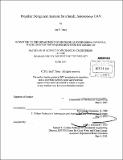Propeller design and analysis for a small, autonomous UAV
Author(s)
Tracy, Ian Patrick
DownloadFull printable version (8.078Mb)
Other Contributors
Massachusetts Institute of Technology. Dept. of Mechanical Engineering.
Advisor
Robert John Hansman, Jr.
Terms of use
Metadata
Show full item recordAbstract
An experimental study was performed to design and analyze a "pusher" propeller for use by a small, expendable, autonomous unmanned aerial vehicle (UAV) whose mission was to descend from 30,000 feet to sea level at an approximately constant descent rate over a 3-hour mission duration. The entire propeller design process, from airfoil selection to final part generation in the computer-aided drafting program SolidWorks is described. QMIL and QPROP were the programs of choice for producing a propeller design focused on yielding minimum induced losses for optimal aerodynamic efficiency given a conservative aerodynamic design point. The TA22 airfoil defined the propeller cross section and NEU-012-030-4000 DC brushless motor was selected to power the propeller. The initial propeller design was modified to comply with size constraints set by the mission. Wind tunnel tests were conducted to determine the effect of fuselage blanketing on propeller performance. Of particular interest was comparing the power required to propel the aircraft at a given airspeed for a configuration in which the propeller was mounted behind the fuselage, and one in which the propeller was not obstructed by an upstream object and instead isolated in the incoming airstream. It was empirically found that fuselage blanketing had a significantly detrimental impact on each of the 4 propellers used in testing. It was therefore recommended that the hub section of the propeller be redesigned to mitigate drag and propulsive losses resulting from reduced momentum in the blanketed region of the propeller. This recommendation was applied to the included propeller design and propeller betas in the hub region were reduced using qualitative methods.
Description
Thesis (S.B.)--Massachusetts Institute of Technology, Dept. of Mechanical Engineering, 2011. Cataloged from PDF version of thesis. Includes bibliographical references.
Date issued
2011Department
Massachusetts Institute of Technology. Department of Mechanical EngineeringPublisher
Massachusetts Institute of Technology
Keywords
Mechanical Engineering.